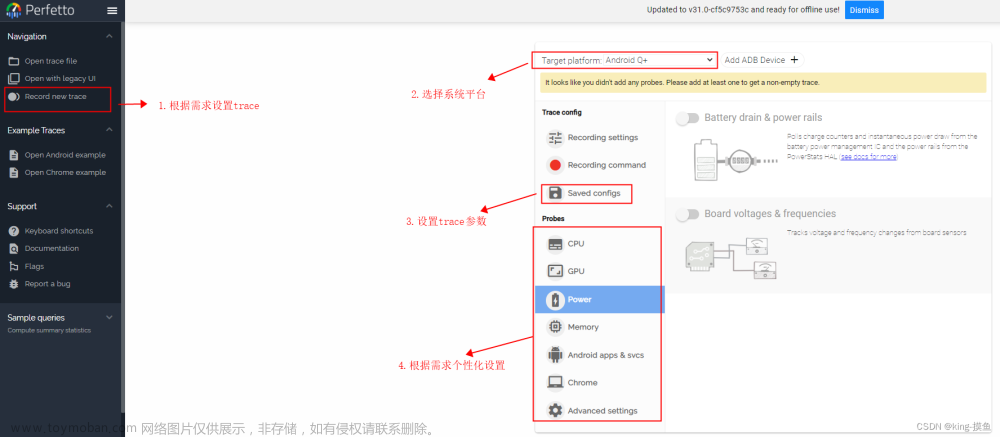描述
用来查看各个组件执行时间的详细信息,但是注意,这个api不会用来测量网络延迟,请求在队列中的等待时间,以及协调节点合并各个分片响应时所花费的时间。
返回结果说明
总体的返回结构
{
"profile": {
"shards": [
{
"id": "[2aE02wS1R8q_QFnYu6vDVQ][my-index-000001][0]", (1)
"searches": [
{
"query": [...], (2)
"rewrite_time": 51443, (3)
"collector": [...] (4)
}
],
"aggregations": [...], (5)
"fetch": {...} (6)
}
]
}
}(1) 当前参与响应的分片,id是唯一的,格式是由 节点名 + 索引名 + 分片 组成
(2) query部分的耗时和其他的debug信息
(3) 累计重写的时间
(4) 每个收集器的名称和调用时间
(5) 聚合部分的消耗时间,调用次数,debug信息
(6) fetch部分的耗时和debug信息
注意:可以通过添加参数 ?human=true 使结果可读,默认的时间都是纳秒。比如像这样

query部分
"query": [
{
"type": "BooleanQuery",
"description": "message:get message:search",
"time_in_nanos": "11972972",
"breakdown": {...},
"children": [
{
"type": "TermQuery",
"description": "message:get",
"time_in_nanos": "3801935",
"breakdown": {...}
},
{
"type": "TermQuery",
"description": "message:search",
"time_in_nanos": "205654",
"breakdown": {...}
}
]
}
]分析:从query的返回结构来看,这个查询被转换成了Lucene底层的带有两个termQuery的BooleanQuery。type是Lucene底层匹配到的类名,它和elasticsearch的别名是对应的。description描述的Lucene的解析文本,用来区分查询的各个部分。time_in_nanos 是BooleanQuery查询的总耗时,这里约为11毫秒,包含两个子查询的。breakdown部分给出的是更详细的时间花费信息。
breakdown
breakdown包含的信息如下
"breakdown": {
"set_min_competitive_score_count": 0,
"match_count": 5,
"shallow_advance_count": 0,
"set_min_competitive_score": 0,
"next_doc": 39022,
"match": 4456,
"next_doc_count": 5,
"score_count": 5,
"compute_max_score_count": 0,
"compute_max_score": 0,
"advance": 84525,
"advance_count": 1,
"score": 37779,
"build_scorer_count": 2,
"create_weight": 4694895,
"shallow_advance": 0,
"create_weight_count": 1,
"build_scorer": 7112295
}字段信息:
create_weight:生成查询权重所消耗的时间,lucene要求为每个查询要生成一个weight对象,这个用来保存查询相关联的一些上下文信息。
build_scorer:生成打分器消耗的时间,打分器是为每个文档的匹配程度打分的机制。如果有启用缓存机制,那也可能包含连带的缓存时间。
next_doc:确定那个文档是下一个匹配文档所需要的时间
advance:advance 是低版本的next_doc,区别是需要额外的查询来确定匹配的下一个文档,比如识别,移动跳过 之前的文档等。
match:某些查询,采用的是两阶段来确定匹配的文档。比如说短语查询,首先会先粗略的检查文档的存在,之后再此基础上会进行第二次更加细致的检查,像检查短语的顺序,距离等。这个记录的就是这种查询的消耗。如果没有这样两阶段的查询,那这个值就是0。
score:打分器打分所消耗的时间。
*_count:记录的是调用对应方法的次数,比如next_doc_count,意思是调用nextDoc()这个方法的次数,它的作用是用来帮助判断lucene是怎么选择查询的。
collectors
collector记录的是一些高级执行的详细信息,返回的结构是这个样子
"collector" : [
{
"name" : "CancellableCollector",
"reason" : "search_cancelled",
"time" : "54micros",
"time_in_nanos" : 54091,
"children" : [
{
"name" : "SimpleTopScoreDocCollector",
"reason" : "search_top_hits",
"time" : "28.8micros",
"time_in_nanos" : 28880
}
]
}
]这里看到了一个CancellableCollector包裹了一个SimpleTopScoreDocCollector,SimpleTopScoreDocCollector的作用默认是用来打分和排序的。reason是针对这个类的英文描述,time_in_nanos是总消耗的时间。要注意的是collector的时间是独立的,是单独于query的。下面是各个reason的说明
search_sorted:为文档打分和排序的收集器,这是最常见的。
search_count:只统计匹配文档数量的收集器,不会去拉取文档的数据,当size=0的时候会看到它。
search_terminated_after_count:在匹配到n个文档后停止搜索的收集器,在查询是指定terminated_after_count(实际测试没有发现这个参数的使用场景)参数后可以看到它。
search_min_score:仅返回得分大于n的收集器,在设置参数min_score是可以看到。
search_muilt:一个收集器包含了多个收集器,在一个查询中包含了,搜索,聚合,全局的聚合,post_filter 的时候会出现这种情况。
search_timeout:指定超时后停止执行的收集器,在设置timeout后会看到它。
aggregation:用来收集聚合部分文档的收集器,在name上看到的会是一个聚合的列表,就像这样

global_aggregation:针对全局查询范围聚合的收集器。
rewrite
rewrite指的是lucene查询或者子查询被优化改变的过程,比如BoolQuery->BoolQuery->TermQuery会被优化为TermQuery。rewrite_time记录的是总的rewrite时间。
注意:对于MultiTermQuery 类的查询,这类查询通常包括通配符查询,模糊查询,正则查询等。这一类的查询有与lucene的运行机制,通常不会返给你一个结构化的结果,这种如果不好分析,直接关注总的消耗时间就是了。
aggregation部分
返回的结构
{
"profile": {
"shards": [
{
"aggregations": [
{
"type": "NumericTermsAggregator",
"description": "my_scoped_agg",
"time_in_nanos": 79294,
"breakdown": {
"reduce": 0,
"build_aggregation": 30885,
"build_aggregation_count": 1,
"initialize": 2623,
"initialize_count": 1,
"reduce_count": 0,
"collect": 45786,
"collect_count": 4,
"build_leaf_collector": 18211,
"build_leaf_collector_count": 1,
"post_collection": 929,
"post_collection_count": 1
},
"debug": {
"total_buckets": 1,
"result_strategy": "long_terms",
"built_buckets": 1
}
},
{
"type": "GlobalAggregator",
"description": "my_global_agg",
"time_in_nanos": 104325,
"breakdown": {
"reduce": 0,
"build_aggregation": 22470,
"build_aggregation_count": 1,
"initialize": 12454,
"initialize_count": 1,
"reduce_count": 0,
"collect": 69401,
"collect_count": 4,
"build_leaf_collector": 8150,
"build_leaf_collector_count": 1,
"post_collection": 1584,
"post_collection_count": 1
},
"debug": {
"built_buckets": 1
},
"children": [
{
"type": "NumericTermsAggregator",
"description": "my_level_agg",
"time_in_nanos": 76876,
"breakdown": {
"reduce": 0,
"build_aggregation": 13824,
"build_aggregation_count": 1,
"initialize": 1441,
"initialize_count": 1,
"reduce_count": 0,
"collect": 61611,
"collect_count": 4,
"build_leaf_collector": 5564,
"build_leaf_collector_count": 1,
"post_collection": 471,
"post_collection_count": 1
},
"debug": {
"total_buckets": 1,
"result_strategy": "long_terms",
"built_buckets": 1
}
}
]
}
]
}
]
}
}这里的type,description,time_in_nanos,breakdown同query部分的作用是一样的,这里不做赘述。不同的是返回了一个debug的信息,这个主要描述的是聚合底层的一些特性。
breakdown
"breakdown": {
"reduce": 0,
"build_aggregation": 30885,
"build_aggregation_count": 1,
"initialize": 2623,
"initialize_count": 1,
"reduce_count": 0,
"collect": 45786,
"collect_count": 4,
"build_leaf_collector": 18211,
"build_leaf_collector_count": 1
}这里也是一样的,如build_leaf_collector 表示的是调用底层方法getLeafCollector()消耗的时间,需要注意的是reduce当前是保留的,它总是会返回0。
fetch部分
当一个查询需要召回文档的时候,它就会有fetch的部分,像这样:
GET /my-index-000001/_search?filter_path=profile.shards.fetch
{
"profile": true,
"query": {
"term": {
"user.id": {
"value": "elkbee"
}
}
}
}返回的结构会是这个样子:
{
"profile": {
"shards": [
{
"fetch": {
"type": "fetch",
"description": "",
"time_in_nanos": 660555,
"breakdown": {
"next_reader": 7292,
"next_reader_count": 1,
"load_stored_fields": 299325,
"load_stored_fields_count": 5,
"load_source": 3863,
"load_source_count": 5
},
"debug": {
"stored_fields": ["_id", "_routing", "_source"]
},
"children": [
{
"type": "FetchSourcePhase",
"description": "",
"time_in_nanos": 20443,
"breakdown": {
"next_reader": 745,
"next_reader_count": 1,
"process": 19698,
"process_count": 5
},
"debug": {
"fast_path": 4
}
}
]
}
}
]
}
}这里time_in_nanos表示的总的消耗时间,next_reader 作用可以对比next_doc,load_source表示加载source的时间,load_stored_fields 表示加载存储字段的时间。debug列出的是杂项的非计时信息。
使用的局限性
profile开销比较大,不能用于生产。
网络开销它没有办法分析到。
在队列中的花费,协调节点上的合并开销没有办法分析到。
suggestions, highlighting, dfs_query_then_fetch 这类的api分析不到
聚合中的reduce部分当前是没有用的。文章来源:https://www.toymoban.com/news/detail-701232.html
返回的结构内容可能会随着版本的变化而变化。文章来源地址https://www.toymoban.com/news/detail-701232.html
到了这里,关于ES-使用profile做性能分析的文章就介绍完了。如果您还想了解更多内容,请在右上角搜索TOY模板网以前的文章或继续浏览下面的相关文章,希望大家以后多多支持TOY模板网!












